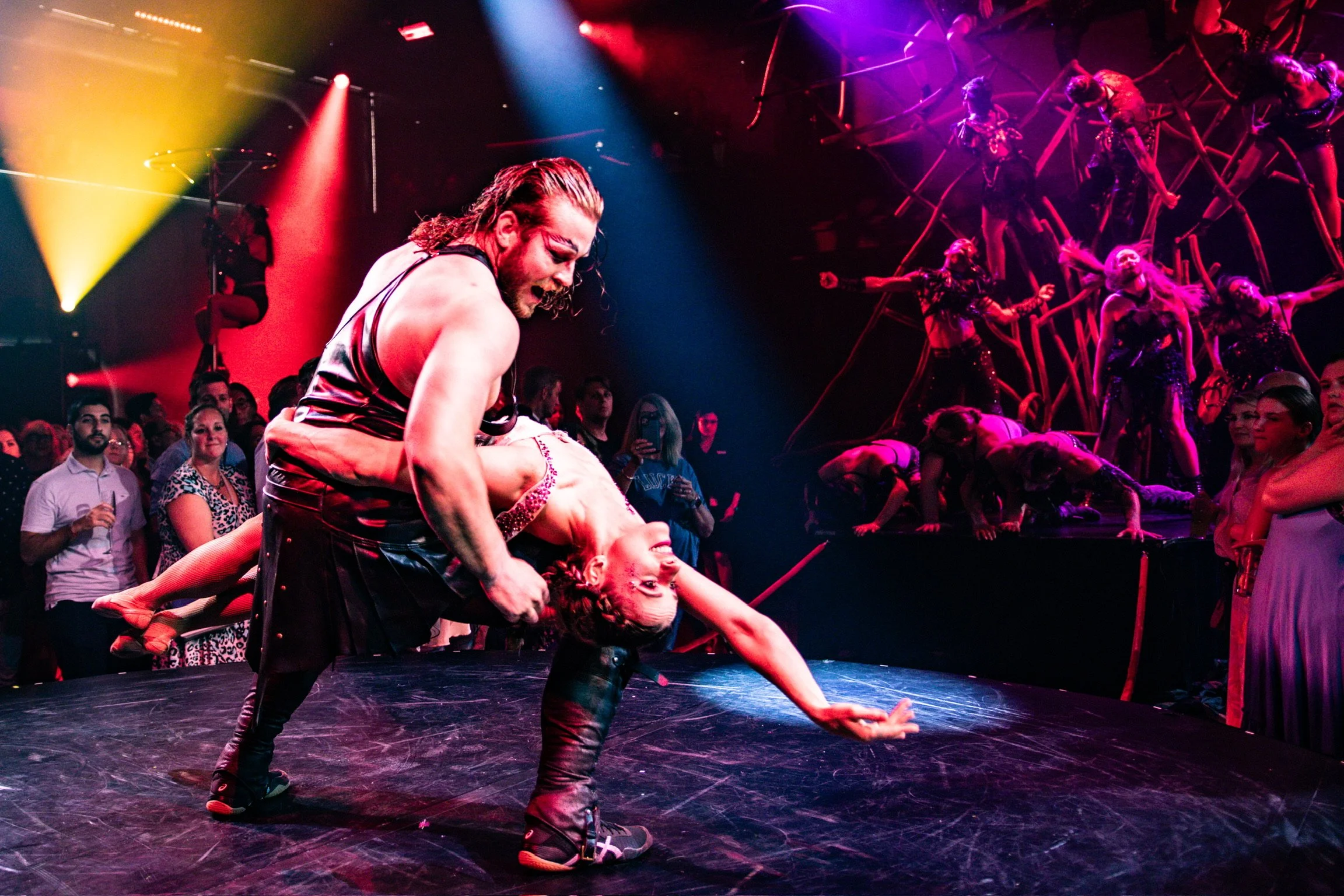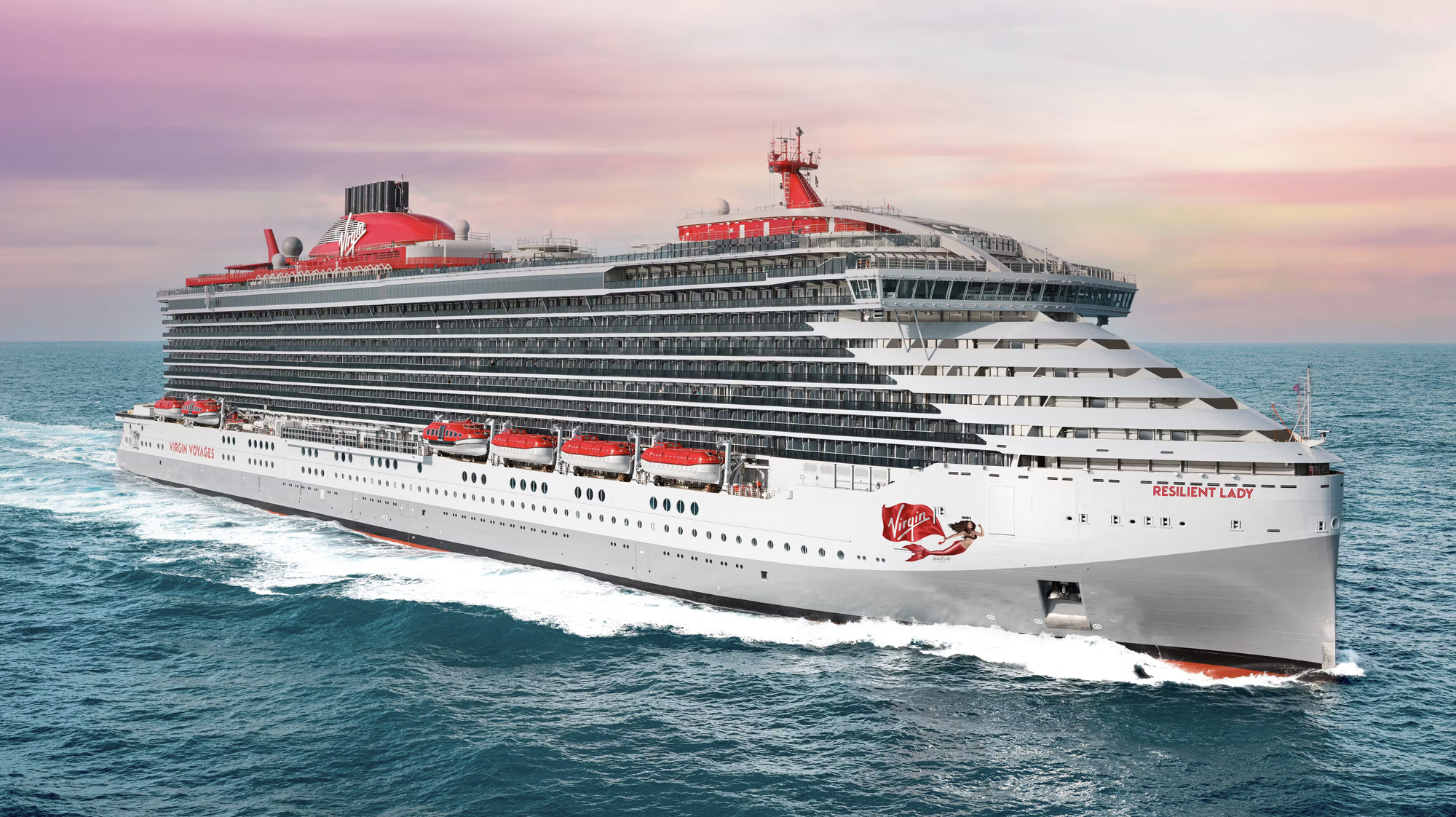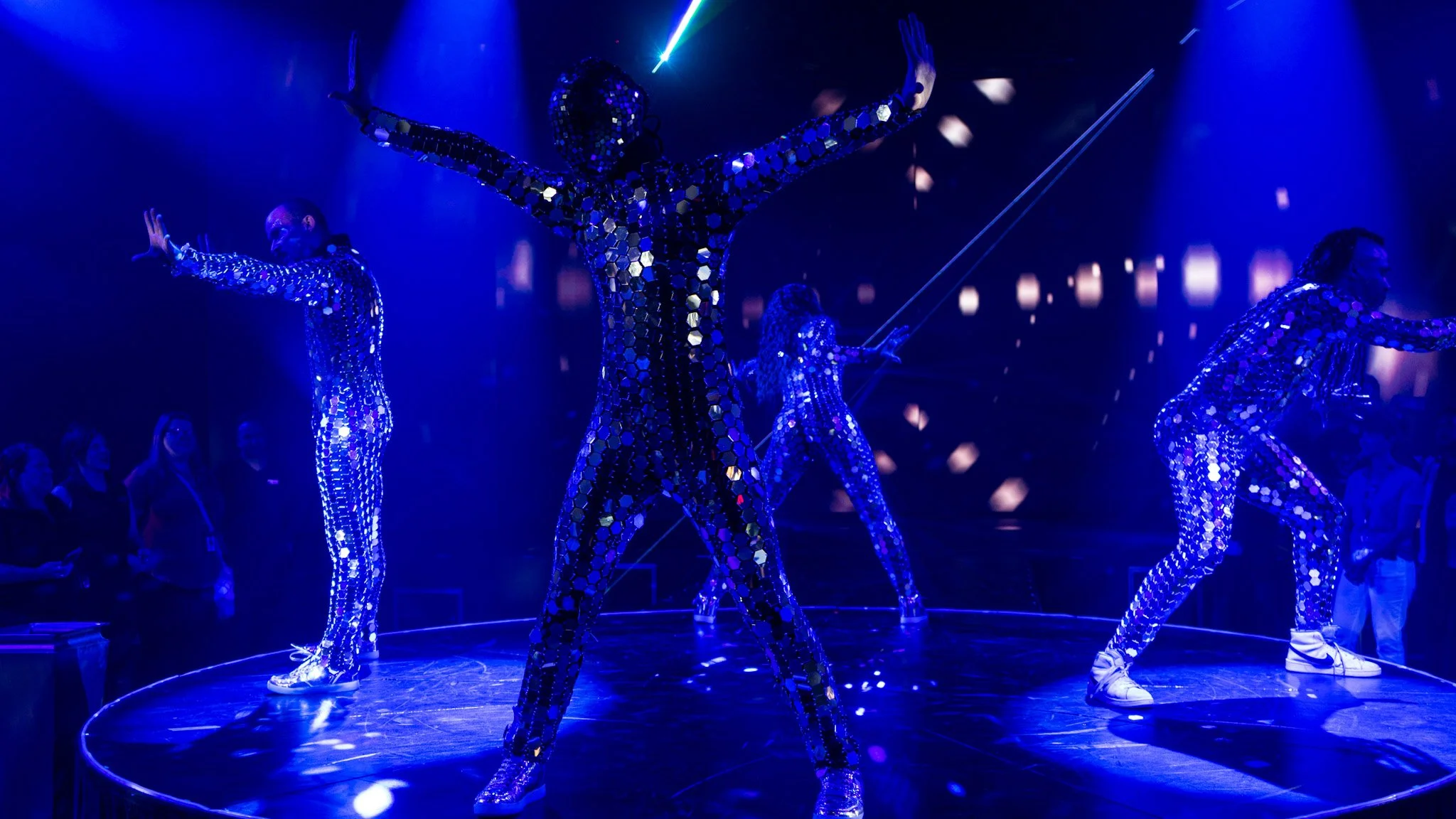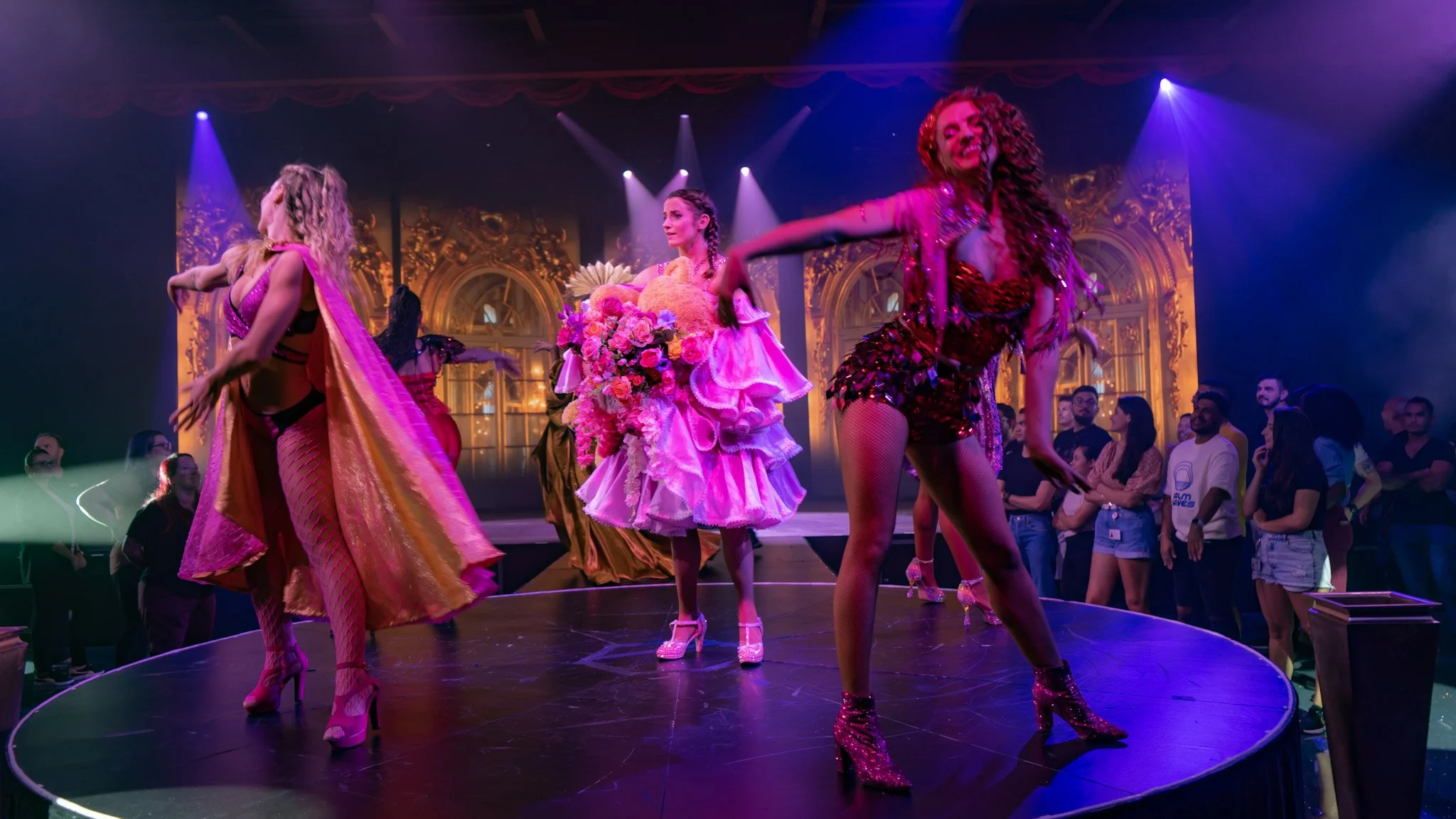“UN ESPECTACULO FUERA DE SERIE”
A bordo de uno de los más modernos y elegantes cruceros de la naviera Virgin Voyages, el Resilient Lady, se encuentra la puesta en escena del espectáculo Persephone.
Producido por Kaleidoscope Entertainment bajo la dirección y producción de Holly - Anne Devlin, Persephone es un espectáculo lleno de magia, pasión y talento que cada noche llena de vida una de las experiencias marítimas mas espectaculares hoy en dia.
"A One-of-a-Kind Show"
On board one of the most modern and elegant cruise ships from Virgin Voyages, the Resilient Lady, you'll find the staging of the show Persephone.
Produced by Kaleidoscope Entertainment under the direction and production of Holly-Anne Devlin, Persephone is a show full of magic, passion, and talent that brings one of today’s most spectacular maritime experiences to life every night.
RESEÑA
Persephone
Por Mariana Mijares
Actualmente navegando a bordo del Resident Lady —uno de los barcos más nuevos y sofisticados de Virgin Voyages—, Persephone es un espectáculo inmersivo que reimagina el mito griego desde una perspectiva moderna y sensorial.
Diseñado exclusivamente para viajeros mayores de 18 años, este crucero de lujo se inspira en la estética de los superyates y cuenta con espacios creados por renombrados arquitectos y diseñadores internacionales como Tom Dixon y Concerte Amsterdam.
En ese contexto, Perséfone, producido por Kaleidoscope Entertainment, fusiona teatro contemporáneo con el mito clásico. Bajo la dirección y visión de Holly-Anne Devlin (también responsable de la dirección circense y la creación de los números aéreos), el espectáculo destaca por su propuesta técnica y riqueza visual.
Un mito reimaginado
Antes siquiera de que inicie formalmente el espectáculo, el ambiente comienza a transformarse. En el pre-show de Perséfone, una mujer cuelga de un aro suspendido en el aire, girando con gracia al ritmo de “Waiting for Tonight”, como si la letra de JLo fuera una premonición: la espera ha terminado y la noche promete emociones intensas.
La danza aérea continúa con “Bad Romance” de Lady Gaga, mientras el espacio se tiñe de luces azules, rosas y verdes que se reflejan en los rostros expectantes del público.
Gracias a la configuración del lugar: un escenario central rodeado por los asistentes, no hay barreras entre artista y espectador. Todos están de pie, formando un círculo íntimo que convierte la experiencia en algo compartido.
El espectáculo se despliega como una sinfonía de disciplinas: proyecciones en video, coreografía contemporánea, acrobacias de alto nivel, y una narrativa que entreteje mito y empoderamiento femenino.
La iluminación cambia de pronto: una luz blanca inunda el escenario mientras las pantallas del fondo proyectan la imagen de un castillo barroco, con ventanas altas, detalles dorados y cortinas rojas. Desde el techo cuelga una cascada de flores, como si un jardín entero hubiera sido suspendido en el aire. La atmósfera se vuelve mágica, entre cabaret glamuroso y fantasía mitológica.
Uno de los personajes clave: Deméter, la diosa de la agricultura, introduce la historia hablando de su hija: Perséfone. Mientras tanto, bailarines se mueven al ritmo de tambores, y reaparece la bailarina aérea, convertida ahora en un símbolo de libertad. Perséfone, interpretada con carisma y fuerza, toma protagonismo al ritmo de “You Don’t Own Me” de Lesley Gore —que se convierte en su leitmotiv—, para expresar su rechazo a someterse y su necesidad de algo más: pasión, libertad, amor.
La historia avanza como un mosaico de actos circenses, cuadros dancísticos y efectos visuales: acróbatas ejecutan saltos increíbles, bailarines en trajes de lentejuelas bailan a centímetros del público, luces y pantallas integran un espectáculo sensorial que supera los estándares de los shows que tradicionalmente se ven en altamar.
En los momentos de acrobacia aérea, el show alcanza puntos hipnóticos gracias a la dirección de Dreya Weber, reconocida por su trabajo con P!nk y Magic Mike. Cada movimiento suspendido en el aire se convierte en metáfora del viaje emocional de Perséfone.
La realización de la escenografía corrió a cargo de PlayHouse Entertainment, quienes construyeron todo el set en su taller en la Ciudad de México y participaron produciendo algunas piezas del vestuario. Su reto no era menor: adaptar y construir una escenografía para condiciones extremas de movimiento y estrictas normas de seguridad propias de un crucero, muy distintas a las de una obra de teatro convencional o un tour terrestre.
En las pantallas, personajes excéntricos, que conforman una especie de moderno coro griego, narran con humor e ironía los días de Perséfone recolectando flores.
El tono cambia cuando regresa Deméter, ahora envuelta en un vestido amarillo, para interpretar “Hurt” de Christina Aguilera. Su voz transmite el dolor de una madre al perder a su hija. En escena, su capa amarilla se transforma en blanca, simbolizando el Inicio del invierno.
El diseño de vestuario, a cargo de Tristan Raines, refuerza cada giro narrativo con detalles vibrantes, texturas que mutan y transformaciones que, como los cuerpos en movimiento, también impulsan la historia.
El ritmo se eleva con un número de tres jóvenes ejecutando acrobacias sincronizadas, seguido de una explosión de energía con bailarines en trajes LED que electrifican el escenario al ritmo de beats electrónicos. En un guiño al empoderamiento femenino, también se escucha “Survivor” de Destiny’s Child, que se convierte en un himno de resistencia: tres mujeres ascienden por una estructura metálica, celebrando la resiliencia femenina.
Más tarde, una artista aérea sube a un columpio al ritmo de “Titanium” de David Guetta, su acto transmite determinación, fortaleza e independencia. Es la declaración final de que Perséfone será dueña de su destino.
Así se llega al final del mito, y del show: cuando Perséfone esté con Hades en el Inframundo, Deméter llorará y la tierra entrará en otoño e invierno. Pero cuando regrese con su madre, todo florecerá. Y eso es justo lo que ocurre en el clímax: una explosión de flores, colores, celebración y vida.
Para el cierre, los bailarines regresan con una coreografía grupal al ritmo de “I’m Still Standing” de Elton John, seguida de “I Love It” de Icona Pop. Todos celebran; incluida Perséfone, mientras que el público se queda bailando… con la emoción de haber presenciado un espectáculo que reimagina la mitología y que redefine el potencial de un show en altamar.
Persephone Chronicle
By Mariana Mijares
Currently sailing aboard the Resident Lady (one of Virgin Voyages’ newest and most sophisticated ships) Persephone is an immersive production that reimagines the Greek myth from a modern, sensory-driven perspective.
Exclusively designed for travelers aged 18 and over, this luxury cruise draws inspiration from the aesthetics of superyachts, with spaces crafted by world-renowned architects and designers like Tom Dixon and Concerte Amsterdam.
In this context, Persephone, produced by Kaleidoscope Entertainment, blends contemporary theater with a classical myth. Under the direction and vision of Holly-Anne Devlin (who also led the circus direction and created the aerial numbers) the show stands out for its technical ambition and visual richness.
A Myth Reimagined
Before the show even begins, the atmosphere starts to shift. In Persephone’s pre-show, a woman hangs from an aerial hoop, gracefully spinning to the rhythm of “Waiting for Tonight”—as if JLo’s lyrics were a prophecy: the wait is over, and the night promises intensity.
The aerial dance continues with Lady Gaga’s “Bad Romance”, as the space fills with blue, pink, and green lights reflecting on the expectant faces of the audience.
Thanks to the venue’s setup: a central stage surrounded by standing spectators, there are no barriers between performer and audience. Everyone stands together in an intimate circle, turning the experience into something shared.
The show unfolds like a symphony of disciplines: video projections, contemporary choreography, high-level acrobatics, and a storyline that interweaves myth and female empowerment.
Suddenly, the lighting shifts: a bright white flood lights up the stage as a baroque castle appears on the backdrop screens: tall windows, golden details, red curtains. A cascade of flowers hangs from the ceiling, as if an entire garden were suspended in air. The mood becomes magical, a blend of glamorous cabaret and mythological fantasy.
One of the key figures: Demeter, the goddess of agriculture, introduces the story by speaking about her daughter: Persephone. Meanwhile, dancers move to the beat of drums, and the aerial dancer reappears, now transformed into a symbol of freedom.
Persephone, portrayed with both charisma and strength, takes center stage to Lesley Gore’s “You Don’t Own Me”—a song that becomes her anthem—expressing her refusal to be subdued and her longing for something more: passion, freedom, love.
The story moves forward like a mosaic of circus acts, dance sequences, and visual effects: acrobats perform breathtaking jumps, dancers in sequin outfits move within inches of the audience, and a fusion of lights and screens creates a sensory show that surpasses traditional expectations for entertainment at sea.
In its aerial moments, the show reaches hypnotic peaks thanks to direction by Dreya Weber (known for her work with P!nk and Magic Mike). Every suspended motion becomes a metaphor for Persephone’s emotional journey.
The set was built by PlayHouse Entertainment, who crafted the entire design in their Mexico City workshop and also helped produce some of the costumes. Their challenge was considerable: building a set that could withstand extreme motion and meet the rigorous safety standards unique to a cruise ship; entirely different from a traditional stage play or land-based tour.
On the screens, eccentric characters (forming a sort of modern Greek chorus) narrate Persephone’s days picking flowers with humor and irony. The tone darkens when Demeter returns, now dressed in yellow, to sing Christina Aguilera’s “Hurt.” Her voice channels the grief of a mother losing her daughter. On stage, her yellow cloak fades into white, signaling the start of winter.
Costume design by Tristan Raines amplifies each narrative turn with vibrant details, shifting textures, and transformations that, much like the moving bodies on stage, help propel the story forward.
The energy intensifies with a synchronized acrobatic number by three young performers, followed by an explosion of movement as dancers in LED suits electrify the stage with pulsing electronic beats. In a nod to female empowerment, “Survivor” by Destiny’s Child starts, becoming an anthem of resilience, as three women climb a metal structure, celebrating feminine strength.
Later, an aerial artist rises on a swing to David Guetta’s “Titanium.” Her act radiates strength, and independence. It’s the final declaration that Persephone will take control of her fate.
And so the myth, and the show, reach their conclusion: when Persephone is with Hades in the Underworld, Demeter mourns and the earth slips into fall and winter. But when Persephone returns to her mother, everything blooms. That’s exactly what happens in the finale: an explosion of flowers, color, celebration, and life.
For the ending, the dancers return for a group routine to Elton John’s “I’m Still Standing”, followed by Icona Pop’s “I Love It”. Everyone celebrates, including Persephone, while the audience keeps on dancing… thrilled to have witnessed a show that reimagines Greek mythology and that truly redefines what a performance at sea can be.












